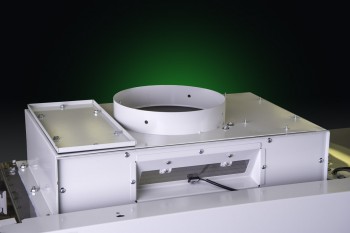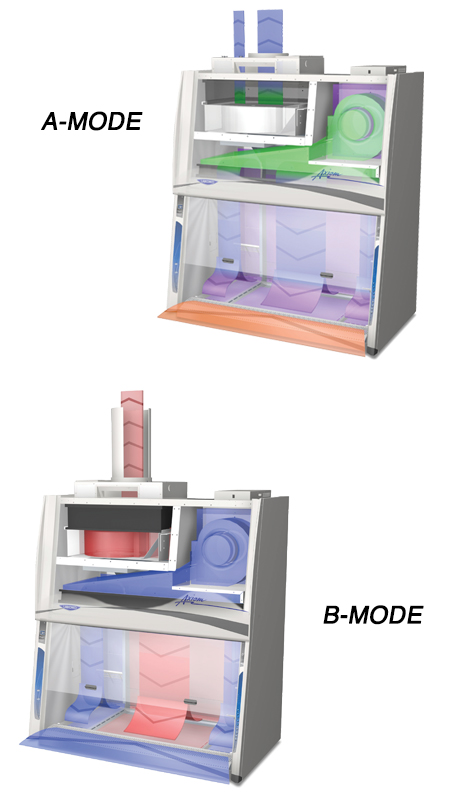Axiom Week: Day 3
FAQs, Myths, Fabrications & Misinformation about the Type C1 Purifier Axiom - Part 3
Can the Axiom be easily changed from room recirculating to exhausting (or vice versa)?
Yes, the Axiom can be changed from Type A mode to B mode in 4 steps. Though there are laboratory balance considerations, modern laboratories outfitted with VAV and lab balance mechanical systems can easily handle the volume of air this entails.
MISINFORMATION: In regard to ventilation, laboratory building requirements today cannot be easily altered.
TRUTH: Scientific laboratories and their mechanical systems are specifically designed to handle changes in laboratory airflow volumes and pressures. Many modern systems can maintain a laboratory’s ventilation automatically, other - older – systems are controlled by a buildings’ facility management control computer.
FABRICATION: In laboratory design, the ventilation requirements for both supply and exhaust are calculated for pressure, air change rates and removal of heat load. If the Axiom’s installation is changed, all of these requirements would have to be recalculated and physically changed.
TRUTH: The balance of a scientific laboratory is based on pressure, air change rates and removal of heat load in accordance with ASHRAE requirements. However, the magnitude of volume being moved by a laboratory is such that the addition or subtraction of an Axiom to/from the lab’s mechanical system is insignificant in many labs.
Even simple VAV systems can automatically adjust for this change based on programmable pressures, and even simpler versions are controlled using a PC interface program.
BENEFITS: The Axiom’s flexibility is made possible by its design and that of existing laboratory ventilation infrastructure. This flexibility makes it possible for a laboratory to save over 50% of operational costs compared to Type B BSCs (over $50,000 compared to the life time operating costs of each Type B2 BSC).
Moreover, it allows facility and laboratory management to maximize the usefulness of their existing laboratory space, eliminating the need to operate both Type A and B BSCs for varying or alternating uses. One Axiom does the job of both Type A and B while costing the institution only the price of a single BSC.
The Axiom can be tied into almost any existing appropriate building exhaust system (with sufficient CFM reserve). Unlike Type B BSCs, no costly dedicated remote blower and ductwork are required.
ADVANTAGE: AXIOM
---
 What is the exhaust connection used on the Axiom?
What is the exhaust connection used on the Axiom?
The Axiom, when installed in B-mode, is connected through a modified exhaust connection – a hybrid between a thimble (‘canopy’) and hard connection – that uses an inlet relief valve as a shock absorber to maintain balance with the buildings remote exhaust system. The inlet relief valve is used to ensure that the exhaust transition plenum is kept under negative pressure in B-mode – maintaining containment of hazardous chemistry in the duct.
MYTH: The inlet relief valve opens in the event that the building exhaust system pulls too much air through the BSC.
TRUTH: Without the inlet relief valve, the coupling between BSC and exhaust would be a so called a ‘push-pull’ system. Such systems are difficult to balance due to systemic pressure fluctuations.
Air is not pulled through a Type C1 by the exhaust system, conversely the exhaust system on a Type B BSC is required to pull air through the BSC. The inlet relief valve is open all the time when the Axiom is operating with proper building exhaust in B-mode.
BENEFITS: Acting like a shock absorber, the inlet relief valve is an adaptive technology that balances and maintains negative pressure by allowing a small volume of room air to bleed into the transition plenum.
The inlet relief valve is part of the system that allows the Axiom to operate in either an A-mode or B-mode and makes it flexible enough to work on most building exhaust systems with sufficient CFM capacity in reserve.
ADVANTAGE: AXIOM
---
MYTH: The Axiom’s Active Protection Protocol positively pressurizes ductwork, pushing potential volatiles within the duct airflow into undesirable areas.
TRUTH: During building exhaust failures, both Class II Type A and Type C BSCs positively pressurize ductwork.
A Type A BSC will do so for an unlimited time, until the BSC is turned off or loses power. What’s more, positive relief valves shunt chemically contaminated air back into the laboratory. Meanwhile, the BSC continues to operate as well, allowing operators to continue their work without forcing a shutdown.
A Type B BSC will not positively pressurize its ductwork. During a remote exhaust failure, Type B BSC must detect an exhaust remote failure within 15 seconds. During this time the cabinet is pressurized and the user is in the path of air from the work area back into the laboratory, characterized as “puff-back” – as defined by NIH/CDC in the BMBL 5th edition
A Type C BSC, such as the Axiom, prevents this positive pressurization from lasting longer than 300 seconds (or 5 minutes); limiting exposure to hazardous chemical vapors.
MISINFORMATION: Per AIHA/ANSI Z9.5-2012, section 5.4.3.5, Laboratory Ventilation. “Pressurizing contaminated ducts is not a recommended practice.”
TRUTH: ANSI Z9.5, Section 5.4.3.5 does not make this statement regarding positively pressurizing ductwork. ANSI Z9.5 for Laboratory Ventilation only briefly mentions Class II BSCs in the ventilation (section 5) and merely describes the types of connections and requirements for manifolding (ganging) BSCs with hoods and general exhaust.
From ANSI/AIHA Z9.5-2012, Appendix 4. Audit Form “Systems and ductwork are designed to maintain negative pressure within all portions of the ductwork inside the building when the system is in operation.”
BENEFITS: Existing Standards and equipment manufacturers all agree, positively pressurizing chemically contaminated ductwork under normal operation is not recommended.
The Active Protection Protocol that positively pressurizes duct work is an emergency response mode – not an operational mode. It does provide containment for a programmable period, not to exceed 5 minutes. During which the Type C1 Axiom provides an audible alarm, visual alarm – describing the alarm occurrence, and provides a countdown timer to BSC shutdown.
On many VAV mechanical systems, ganged exhaust pipes run to a central large volume plenum. These large VAV mechanical systems are significant enough in volume to absorb the volume of air being moved by an Axiom with the Active Protection Protocol engaged.
If a facility wishes to not have their ductwork positively pressurized, then the program can be set to operate for zero seconds.
Regardless of building exhaust system failure or normal BSC shutdown, the Axiom’s exhaust blower always runs for 10 seconds longer than the supply fan – eliminating any risk of pressurizing the BSCs interior, forcing air into the laboratory.
The Axiom meets all requirements under ANSI Z9.5, NFPA 45, and NSF/ANSI 49 under normal operation. It also maintains an extended safety period during a critical building system failure.
ADVANTAGE: AXIOM
---
Watch the video to learn about our exclusive Omni-Flex feature.
In case you missed it, here is our video about the Chem-Zone airflow pattern.
Return to Labconco.com to learn more about the Type C1 every day this week. Tomorrow we answer the question, "Can the Axiom replace a Type B2 BSC?"
Hint: The answer is yes.
This is Day 3 of Axiom Week, see our post for: Day 1 | Day 2 | Day 4 | Day 5
| chevron_left | Axiom Week: Day 4 | Articles | Axiom Week: Day 2 | chevron_right |







